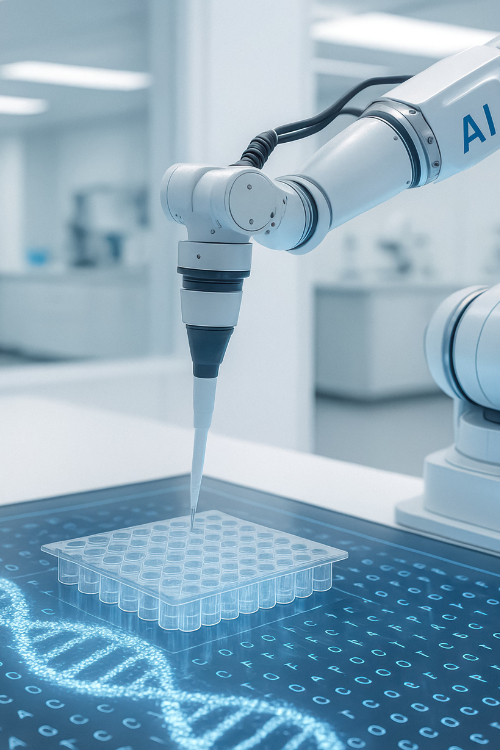Medical technology and IT (information technology) are increasingly converging and driving the digital revolution in healthcare. The advantages are already clear: robot-assisted surgical procedures had been used in over 16 million operations worldwide by 2024 - a strong indication of the potential this technology has for the future of surgery.
In Germany, too, the use of systems such as Da Vinci is steadily increasing.

Imaging techniques also generate so much data that artificial intelligence (AI) is used for data analysis and initial diagnoses.
At the same time, wearables are driving the personalization of medicine and offering patients a level of care that would be almost impossible to provide with human staff alone.
The advantages are evident: they continuously record vital signs, issue warnings, and make recommendations, both in private use and in hospitals. They can also support rehabilitative applications and relieve the burden on medical providers.
Robot-assisted surgical procedures have been proven to reduce the length of hospital stays, thereby relieving the burden on hospital capacities. In addition, complication rates and rehospitalizations can be minimized.
Finally, a study by the Technical University of Berlin shows that assistance systems often make better decisions on their own. The precision of the technology already surpasses that of humans, who tend to intervene correctively out of uncertainty or overconfidence.
Challenges
Despite the progress made, key obstacles remain. When it comes to diagnosing findings, AI systems still operate like a black box. Doctors are rarely able to understand how a diagnosis is reached.
Another problem is financing, as there is a gap between investment needs and financing at the hospitals that perform the procedures. Support programs such as the Hospital Future Act (KHZG) are an important first step. Robotic assistance systems, for example, have been included as a funding criterion. However, this does not offer a long-term perspective for continuous modernization.
Med-tech providers also face financial hurdles. The industry also complains about extensive regulatory requirements - according to the BVMed autumn survey 2025, 86% of the companies surveyed would like to see less bureaucracy.
Small and medium-sized enterprises (SMEs) in particular quickly reach their limits due to regulations and investments. The medical technology industry consists mainly of SMEs.
At the same time, modern medical technology is becoming increasingly complex: today's devices are essentially highly complex IT systems that communicate with cloud infrastructures, use machine learning, and integrate seamlessly into digital health ecosystems. An MRI scanner today is as much a software product as it is a medical device.
This also increases the importance of cybersecurity, interoperability, and data management. Here, too, SMEs are particularly sought after to contribute their core competencies in cooperation with IT companies or to seek advice from external providers.
There are funding opportunities available specifically for SMEs in Germany to help them meet these challenges.
Opportunities for collaboration
Research and development collaborations
The Federal Ministry of Education and Research (BMFTR), for example, supports SMEs in medical technology that operate in an extremely dynamic environment and under very demanding regulatory requirements for medical devices. Programs such as the Medical Technology Program promote networking between science and clinical application. Joint research and development (R&D) projects can thus minimize risks and accelerate innovation. Here, too, knowledge of core competencies is important.
Strategic partnerships in product development
Medical technology companies contribute expertise in mechanics, materials, and regulatory requirements, while IT companies offer cloud structures, AI algorithms, and software development.
Strategic industry convergence is giving rise to new solutions. On the one hand, through the development of AI-driven, automated medical devices, which are already in use as described above. Or through the development of (AI-supported) software for therapeutic and diagnostic solutions (software as a medical device).
On the other hand, cloud networks and data collection can support the creation of a digital twin that offers comprehensive benefits in research and treatment. It supports the simulation of therapies, predictive analysis of disease progression, personalized treatment, and the optimization of clinical processes.
Networked systems such as the Internet of Medical Things (IoMT), which supports remote work and provides personalized therapy or software applications for hospitals (HIS) or imaging procedures (PACS), also benefit from interdisciplinary collaboration. However, the secure handling of sensitive health data remains a prerequisite.
Outsourcing and consulting
For SMEs, it can make sense to outsource IT structures or cloud solutions. External service providers offer cost efficiency, flexibility, and expertise. A personnel consulting firm can use its experience to facilitate the appropriate collaboration or find a consultant who specializes in complex data sets and data protection regulations (GDPR).
Critical data sets that are collected and used in medical applications require separate consulting. The higher the quality of the collected data, the better it can be used in applications and research.
Example
An interesting example of successful cooperation is the company Diabeloop, a research team of diabetologists that has developed a self-learning algorithm for insulin control in collaboration with a laboratory for information electronics and university hospitals. The DBLG1 algorithm has already been incorporated into Roche's Accu-Check Insight insulin pump and is now also available with the Dana-i insulin pump from manufacturer SOOIL with the Dexcom sensor, enabling highly precise, personalized therapy. The project shows how many partners are needed for modern medtech products.
For collaborations to succeed, clear governance structures, defined ethical standards, and regulations are still needed. Cross-functional teams, iterative processes, and security checkpoints simplify collaboration.
Conclusion
The close integration of medical technology and information technology is central to the development of forward-looking medical devices and an efficient healthcare system. This poses certain challenges, especially for small and medium-sized enterprises, but these can be overcome through support and targeted cooperation.
In addition, there is a growing demand for skilled workers with hybrid skills who combine medical technology knowledge with data analysis, cyber security, software development, and regulatory requirements. Given the cross-industry shortage of skilled workers, a specialized recruitment consultancy can help identify skills gaps and develop appropriate recruitment strategies.
Artificial intelligence, the Internet of Medical Things, and digital therapeutics are increasingly becoming the standard in medical care and must be integrated into corporate strategy. Collaborations between medical technology and IT companies are creating an innovative market of the future. A specialized recruitment consultancy supports this process by identifying suitable profiles, surveying the market, and helping companies align their organizations with the digital future of medical technology.






